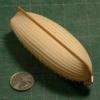-
Posts
13,290 -
Joined
-
Last visited
Content Type
Profiles
Forums
Gallery
Events
Everything posted by druxey
-

Framing Math
druxey replied to vwmiller's topic in Building, Framing, Planking and plating a ships hull and deck
Manual lofting is a tedious process. However, once you get into the rhythm of it, it can go fairly quickly. I've been doing it this way for years. These days I loft manually, scan and clean up the drawings on computer. Sample attached. -

Framing Math
druxey replied to vwmiller's topic in Building, Framing, Planking and plating a ships hull and deck
Theoretically the curves are composed of arcs of circles. However, in practice this is not the case the further ones moves forward and aft of the dead flat frame.... -
The gangway was normally flush to the planksheer at this time period. Nice progress, Toni!
- 1,449 replies
-
Hmm.... Seems like a stretch to me. Sure it is an early anchor but, as they were hard to produce and expensive, might have been in use well into the following century before being lost. Unless there is a log stating that an anchor of that size was lost in that location by one of Columbus' ships, I remain sceptical!
-
Cracking in acrylic might be stress-induced by the bolts being over-tightened?
- 2,207 replies
-
Not so much restore as rebuild! That is a very neat job so far, Paul.
- 53 replies
-
- clipper
- restoration
-
(and 1 more)
Tagged with:
-
A beautiful evening? Beautiful work as well!
- 184 replies
-
- ruby & arthur reed
- lifeboat
-
(and 1 more)
Tagged with:
-
Congrats on your growing family! Your lack of progress is excused, I think. I wish you many happy years in your new home.
-
Quite the month, Kevin! My condolences. Try not to take your electronics to sea again, eh? Hopefully you'll be up and running again soon. I use a Mac Time Capsule as external back-up. As two computers can use it, it came in very useful when my wife's iMac hard drive quit. It was easy for her to download all her files on her new iMac Pro.
- 1,124 replies
-
Looking lovely, Frank. Great job with those raking stern timbers. All those clamps made me think of a row of exotic budgerigars perched on a wire!
-
Lovely progress - but why stop now? Seriously, the model is a gem as is.
- 281 replies
-
- falls of clyde
- tanker
-
(and 2 more)
Tagged with:
-
Those railings and metalwork are first class, Adrian!
- 184 replies
-
- ruby & arthur reed
- lifeboat
-
(and 1 more)
Tagged with:
-

More tools - Luthier, jeweler, fly-tying
druxey replied to vossiewulf's topic in Modeling tools and Workshop Equipment
I believe that in North America these are called Lightning strips. -
Congratulations on completing the framing, Ben. The idea of omitting fillers in a regular pattern is a good one.
- 889 replies
-
If you look at contemporary paintings, ensigns and flags are translucent. The material had a very loose weave, as surviving examples show. You've imitated the effect very well in my opinion, Chuck. Excellent! And the rigging looks great as well.
- 1,051 replies
-
- cheerful
- Syren Ship Model Company
-
(and 1 more)
Tagged with:
-
Oooh, nice! Also love the adjustable spanner (wrench) that you made lo those many years ago. Do I assume that the compass will work when completed? Otherwise you might just use brass for the balls (adolescent snigger).
- 2,207 replies
-
If that is a snatch block, the open side should face forward. It's hard to see whether yours do. Coming along nicely!
- 525 replies
-
- anchor hoy
- hoy
-
(and 1 more)
Tagged with:
-
Make sure that the set comes with the tables for setting any proportion you wish. (The photo above shows the paper chart.)
About us
Modelshipworld - Advancing Ship Modeling through Research
SSL Secured
Your security is important for us so this Website is SSL-Secured
NRG Mailing Address
Nautical Research Guild
237 South Lincoln Street
Westmont IL, 60559-1917
Model Ship World ® and the MSW logo are Registered Trademarks, and belong to the Nautical Research Guild (United States Patent and Trademark Office: No. 6,929,264 & No. 6,929,274, registered Dec. 20, 2022)
Helpful Links
About the NRG
If you enjoy building ship models that are historically accurate as well as beautiful, then The Nautical Research Guild (NRG) is just right for you.
The Guild is a non-profit educational organization whose mission is to “Advance Ship Modeling Through Research”. We provide support to our members in their efforts to raise the quality of their model ships.
The Nautical Research Guild has published our world-renowned quarterly magazine, The Nautical Research Journal, since 1955. The pages of the Journal are full of articles by accomplished ship modelers who show you how they create those exquisite details on their models, and by maritime historians who show you the correct details to build. The Journal is available in both print and digital editions. Go to the NRG web site (www.thenrg.org) to download a complimentary digital copy of the Journal. The NRG also publishes plan sets, books and compilations of back issues of the Journal and the former Ships in Scale and Model Ship Builder magazines.


